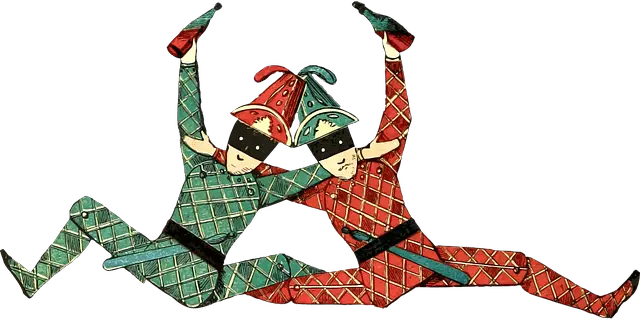
A juggler is a person who throws items into the air and makes a cascade pattern. They then catch these items on a rotational bases. It is proven that jugglers are smart and great at entertaining.
The word “juggle” comes from the Middle English word “jogelen” which means to perform or entertain. The French word “jogler” which means to joke or jest.
History of Juggling
The first evidence of juggling dates back to 2000 BC during the Egyptian era. An Eguptian woman can be seen juggling balls which was featured on ancient pottery.
The Chinese Book of Lie Zi written over 2300 years ago, describes a warrior juggling seven swords at once. Apparently ancient Chinese Warriors used to intimidate their enemies by juggling before they went into battle.
An early Roman juggler Tagatus Ursus used to juggle glass balls. This was according to his engraved tombstone.
In 1056 at the Battle of Hastings, a warrior under William the Conqueror used to perform simple juggling tricks with a sword before taking the head off English soldiers. He liked to claim that this was his first kill of the day.
An interesting fact is in the 1500’s in Ireland if jugglers threw items in the air and they hit or hurt a member of the audience, they would have to pay a fine to the authorities.
In the 1800’s young Tongan girls would juggle with coconuts and limes would often for recreation.
In 1768, jugglers first appeared as top acts in a large circuses. Producer Philip Astley hired jugglers to perform with his troupe in England.
Jugglers in the late 18th century often were the entertainment In theatre during set changes .
In the Middle Ages jugglers were looked down upon by churches and religious groups.. It was seen as frivolous and dabbling with the Occult and Magic, which was akin to evil.
Eventually in the 1600-1700s royalty needed to be entertained so they often employed Jesters in the court to entertain them by using comedy, tricks, juggling and Magic. Hence the term, ‘Court Jester.’
Juggling has been quite popular since the Middle Ages until the late 19th century. Vaudeville was very popular in France and the United States and often utilised jugglers in their performances.
However it wasn’t until motion pictures and film emerged in the late 1800s and early 1900s that juggling in Vaudeville theater began to faze out. From then on juggling became more of a hobby than a way of making a living.

Who are the world’s Most Famous Jugglers
Kristoff and Manual Mistsach are very well-known twin jugglers from Austria. They have won a number of world records throwing a number of items in a row.
Hultgren is ‘Australia’s most prolific record breaker’ and as of July 2016 he holds 44 official ‘Guinness World Records’ for his unusual skills. Some of his records include the ‘Most chainsaws juggled.
Many people consider Anthony Gatto to be the best juggler in the world today. He holds a number of world records and juggling and is in the best shows that have traveled the world such a Cirque du Soleil. check out of video here.
Why do people think juggling is important
Juggling is important for dexterity and loosening of the wrists. It also helps with hand-eye coordination and overall upper body and arm strength.
Juggling is very important for small and large ball skills. It helps in increasing the Mastery of the ball which helps boost confidence in matches and team games. It is especially good in games like soccer softball tee-ball and baseball.
Juggling is deemed very good for keeping fit and keep your weight down, as you are burning 260 calories per hour. Which is the same as walking. You don’t slouch when you are juggling.
What Item is Easiest to Juggle in Large amounts
Apparently juggling rings are the easiest items to juggle in large amounts. A normal juggling ring throwing pattern is called a cascade. Performer can hold a number of rings in both hands coordinated in the air so that many rings can be tossed within a matter of moments. Albert Lucas holds the world record for juggling 13 rings in a row.
What are some of the things you can juggle.
- Ball juggling
- Club juggling
- Ring Juggling
- Cigar Boxes
- Diabolo
- Devil Sticks
- Contact Juggling
- Plate spinning
To name a few.
Does Juggling Make you Smarter?
A study published in the journal Nature finds that learning to juggle may cause certain areas of your brain to grow.
The study looked at a number of jugglers and studied the size of the brain. They concluded that their brains expanded after juggling for a few minutes per day for three months.
The type of MRI scans the researchers used allowed them to focus on structural changes rather than changes in brain activity. Using a sophisticated analysis technique called voxel-based morphology, the researchers were then able to investigate changes in brain gray matter, the area of the brain that consists mostly of the cell bodies of neurons rather than the connective fibers. (Medical News Today)
They found that using an MRI scan, they found that people who practiced juggling for 3 months, had a larger brain or grey matter than those who did not practice juggling.
They also learned that juggling boosts brain development as it accelerates the growth of neural connections related to memory, focus, movement, and vision.
Scientists connected the growth to the visual in spatial awareness part of the brain. However the same people who practice juggling for three months and grew their grey matter, lost the same growth after three months of not juggling.. So the old adage use it or lose it applies here.
How to Begin to Juggle
A great way to first again how to juggle is to use scarfs. Then you can move to small bean bags and then harder items such as clubs and sticks. Apparently rings are the easiest to use when juggling quite a few items at once.
How long it takes you to be confident juggler depends on you. It could be anything from half an to hours to master a trick or a cascade. The more you do it the better you get.
Begin your first juggle, by holding two scarves or juggling balls. Throw one in the air over to the other arm and then throw that scarf into the air towards the other arm. Change it up as you like.
The basic cascade is holding two scarves in one hand and one in the other. Toss one scarf into the air towards the left hand side. Toss one scarf towards the right hand side. As the right hand catches the right scarf the left hand throws up the third scarf and quickly catches the second scarf. Continue until you’ve mastered the cascade.

